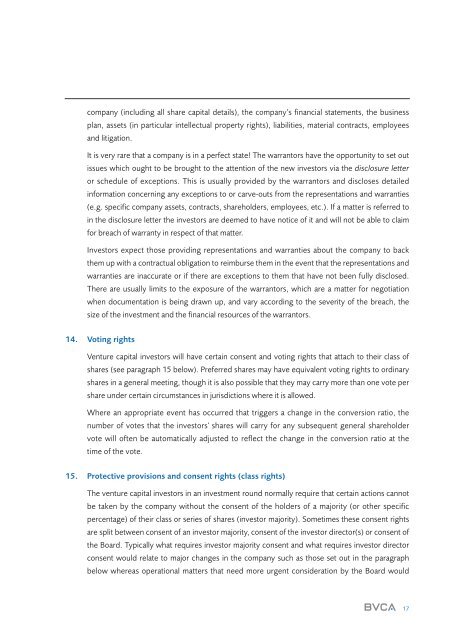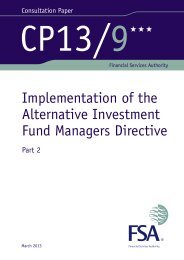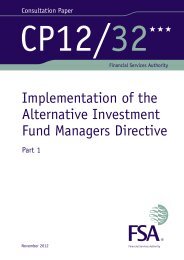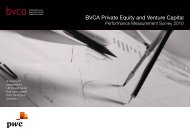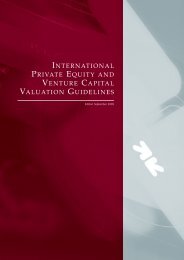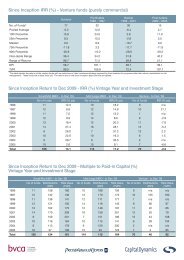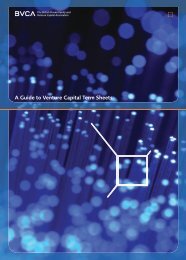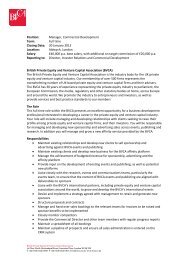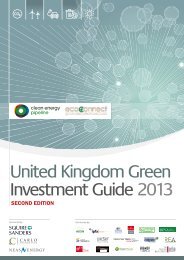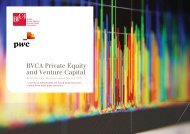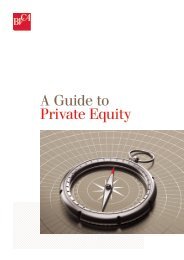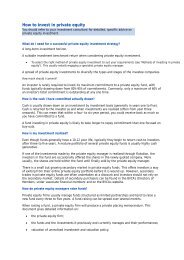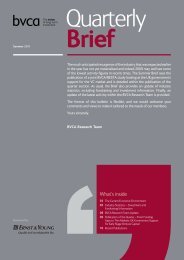Guide to term sheets - BVCA admin
Guide to term sheets - BVCA admin
Guide to term sheets - BVCA admin
Create successful ePaper yourself
Turn your PDF publications into a flip-book with our unique Google optimized e-Paper software.
company (including all share capital details), the company’s financial statements, the business<br />
plan, assets (in particular intellectual property rights), liabilities, material contracts, employees<br />
and litigation.<br />
It is very rare that a company is in a perfect state! The warran<strong>to</strong>rs have the opportunity <strong>to</strong> set out<br />
issues which ought <strong>to</strong> be brought <strong>to</strong> the attention of the new inves<strong>to</strong>rs via the disclosure letter<br />
or schedule of exceptions. This is usually provided by the warran<strong>to</strong>rs and discloses detailed<br />
information concerning any exceptions <strong>to</strong> or carve-outs from the representations and warranties<br />
(e.g. specific company assets, contracts, shareholders, employees, etc.). If a matter is referred <strong>to</strong><br />
in the disclosure letter the inves<strong>to</strong>rs are deemed <strong>to</strong> have notice of it and will not be able <strong>to</strong> claim<br />
for breach of warranty in respect of that matter.<br />
Inves<strong>to</strong>rs expect those providing representations and warranties about the company <strong>to</strong> back<br />
them up with a contractual obligation <strong>to</strong> reimburse them in the event that the representations and<br />
warranties are inaccurate or if there are exceptions <strong>to</strong> them that have not been fully disclosed.<br />
There are usually limits <strong>to</strong> the exposure of the warran<strong>to</strong>rs, which are a matter for negotiation<br />
when documentation is being drawn up, and vary according <strong>to</strong> the severity of the breach, the<br />
size of the investment and the financial resources of the warran<strong>to</strong>rs.<br />
14. Voting rights<br />
Venture capital inves<strong>to</strong>rs will have certain consent and voting rights that attach <strong>to</strong> their class of<br />
shares (see paragraph 15 below). Preferred shares may have equivalent voting rights <strong>to</strong> ordinary<br />
shares in a general meeting, though it is also possible that they may carry more than one vote per<br />
share under certain circumstances in jurisdictions where it is allowed.<br />
Where an appropriate event has occurred that triggers a change in the conversion ratio, the<br />
number of votes that the inves<strong>to</strong>rs' shares will carry for any subsequent general shareholder<br />
vote will often be au<strong>to</strong>matically adjusted <strong>to</strong> reflect the change in the conversion ratio at the<br />
time of the vote.<br />
15. Protective provisions and consent rights (class rights)<br />
The venture capital inves<strong>to</strong>rs in an investment round normally require that certain actions cannot<br />
be taken by the company without the consent of the holders of a majority (or other specific<br />
percentage) of their class or series of shares (inves<strong>to</strong>r majority). Sometimes these consent rights<br />
are split between consent of an inves<strong>to</strong>r majority, consent of the inves<strong>to</strong>r direc<strong>to</strong>r(s) or consent of<br />
the Board. Typically what requires inves<strong>to</strong>r majority consent and what requires inves<strong>to</strong>r direc<strong>to</strong>r<br />
consent would relate <strong>to</strong> major changes in the company such as those set out in the paragraph<br />
below whereas operational matters that need more urgent consideration by the Board would<br />
17


